Process Plant Equipment Market Insights 2025, Analysis and Forecast to 2030, by Manufacturers, Regions, Technology, Application
- Single User License (1 Users) $ 3,200
- Team License (2~5 Users) $ 4,200
- Corporate License (>5 Users) $ 5,200
Introduction
The Process Plant Equipment market comprises machinery and systems critical to industrial processing across oil & gas, refineries, petrochemicals, chemicals & fertilizers, metals & minerals, offshore, water & wastewater treatment, power & desalination, and other sectors. Defined by its capital-intensive nature and technological complexity, this industry supports global infrastructure and energy needs. In 2024, U.S. manufacturing saw sustained investment despite challenges, with the PMI expanding early in the year but contracting by July due to weaker demand and rising inventories. US election in 2024 signals potential policy shifts impacting supply chains and investment. The market thrives on demand for efficiency, sustainability, and resilience in processing plants, with trends leaning toward automation and green technologies amid economic and geopolitical flux.
Market Size and Growth Forecast
The global Process Plant Equipment market is projected to reach USD 110 billion to USD 120 billion in 2025, with a CAGR of 3% to 5% through 2030, expanding to USD 135 billion to USD 150 billion, driven by industrial upgrades and energy transitions.
Regional Analysis
North America: Expected at 2% to 4%, the U.S. leads in oil & gas and power. Trends focus on automation and decarbonization.
Europe: Forecasted at 2% to 4%, Germany and the UK prioritize chemicals and water treatment. Trends emphasize sustainability.
Asia Pacific: Projected at 4% to 6%, China and India drive refineries and metals. Trends favor infrastructure growth.
South America: Anticipated at 3% to 5%, Brazil grows in offshore and mining. Trends lean toward export efficiency.
Middle East and Africa: Expected at 3% to 5%, Saudi Arabia excels in petrochemicals. Trends focus on desalination.
Application Analysis
Oil & Gas: Projected at 3% to 5%, it demands robust equipment. Trends shift to efficiency.
Refineries & Petrochemicals: Expected at 4% to 6%, it grows with energy needs. Trends favor green processes.
Chemicals & Fertilizers: Forecasted at 2% to 4%, it supports agriculture. Trends emphasize safety.
Metals & Minerals: Projected at 3% to 5%, it aids mining. Trends focus on durability.
Offshore: Expected at 4% to 6%, it serves energy extraction. Trends lean toward resilience.
Water & Wastewater Treatment: Projected at 3% to 5%, it grows with urbanization. Trends favor sustainability.
Power & Desalination: Expected at 2% to 4%, it supports energy and water. Trends emphasize renewables.
Others: Anticipated at 1% to 3%, it includes niche uses. Trends vary by application.
Key Market Players
Charles Thompson Ltd: A UK firm, Charles Thompson excels in pressure vessels.
ATB Group: An Italian leader, ATB serves heavy industries.
Integrated Flow Solutions: A U.S. player, IFS focuses on modular systems.
HSM Offshore Energy: A Dutch firm, HSM targets offshore platforms.
Harris Pye: A global entity, Harris Pye specializes in repairs.
Aarya Engineering: An Indian innovator, Aarya crafts processing solutions.
Quality International Co Ltd: A UAE leader, Quality supplies robust equipment.
Porter’s Five Forces Analysis
Threat of New Entrants: Moderate, with high capital and expertise barriers, though modular tech lowers entry.
Threat of Substitutes: Low, as specialized equipment lacks direct alternatives.
Bargaining Power of Buyers: High, with large firms demanding cost-effective, reliable solutions.
Bargaining Power of Suppliers: Moderate, as component suppliers hold leverage, balanced by scale.
Competitive Rivalry: Intense, driven by innovation and project bids in a fragmented market.
Impact of Tariff Conflicts on Supply Chain Localization
Tariff conflicts have accelerated localization in the Process Plant Equipment market, reducing reliance on imported components like steel and electronics. U.S.-China tensions and post-2024 election uncertainties push North American firms to bolster domestic manufacturing, aligning with oil & gas needs, while Europe sources locally for compliance. In Asia Pacific, China and India enhance regional production, cutting costs and supporting rapid industrialization. This shift demands investment in facilities and skills, but it enhances resilience, ensuring supply stability amid trade flux.
Market Opportunities and Challenges
Opportunities
Energy Transition: Green tech drives equipment upgrades.
Urbanization: Water treatment grows with population.
Automation: Efficiency gains attract investment.
Emerging Markets: Asia offers infrastructure potential.
Policy Support: Incentives boost renewable projects.
Challenges
Economic Flux: Demand dips with PMI contraction.
High Costs: Capital intensity limits scalability.
Regulatory Pressure: Emission rules raise expenses.
Supply Chain Risks: Tariffs disrupt component flow.
Competition: Fragmented players vie for contracts.
Chapter 1 Executive Summary
Chapter 2 Abbreviation and Acronyms
Chapter 3 Preface
3.1 Research Scope
3.2 Research Sources
3.2.1 Data Sources
3.2.2 Assumptions
3.3 Research Method
Chapter 4 Market Landscape
4.1 Market Overview
4.2 Classification/Types
4.3 Application/End Users
Chapter 5 Market Trend Analysis
5.1 Introduction
5.2 Drivers
5.3 Restraints
5.4 Opportunities
5.5 Threats
Chapter 6 Industry Chain Analysis
6.1 Upstream/Suppliers Analysis
6.2 Process Plant Equipment Analysis
6.2.1 Technology Analysis
6.2.2 Cost Analysis
6.2.3 Market Channel Analysis
6.3 Downstream Buyers/End Users
Chapter 7 Latest Market Dynamics
7.1 Latest News
7.2 Merger and Acquisition
7.3 Planned/Future Project
7.4 Policy Dynamics
Chapter 8 Historical and Forecast Process Plant Equipment Market in North America (2020-2030)
8.1 Process Plant Equipment Market Size
8.2 Process Plant Equipment Market by End Use
8.3 Competition by Players/Suppliers
8.4 Process Plant Equipment Market Size by Type
8.5 Key Countries Analysis
8.5.1 United States
8.5.2 Canada
8.5.3 Mexico
Chapter 9 Historical and Forecast Process Plant Equipment Market in South America (2020-2030)
9.1 Process Plant Equipment Market Size
9.2 Process Plant Equipment Market by End Use
9.3 Competition by Players/Suppliers
9.4 Process Plant Equipment Market Size by Type
9.5 Key Countries Analysis
9.5.1 Brazil
9.5.2 Argentina
9.5.3 Chile
9.5.4 Peru
Chapter 10 Historical and Forecast Process Plant Equipment Market in Asia & Pacific (2020-2030)
10.1 Process Plant Equipment Market Size
10.2 Process Plant Equipment Market by End Use
10.3 Competition by Players/Suppliers
10.4 Process Plant Equipment Market Size by Type
10.5 Key Countries Analysis
10.5.1 China
10.5.2 India
10.5.3 Japan
10.5.4 South Korea
10.5.5 Southest Asia
10.5.6 Australia
Chapter 11 Historical and Forecast Process Plant Equipment Market in Europe (2020-2030)
11.1 Process Plant Equipment Market Size
11.2 Process Plant Equipment Market by End Use
11.3 Competition by Players/Suppliers
11.4 Process Plant Equipment Market Size by Type
11.5 Key Countries Analysis
11.5.1 Germany
11.5.2 France
11.5.3 United Kingdom
11.5.4 Italy
11.5.5 Spain
11.5.6 Belgium
11.5.7 Netherlands
11.5.8 Austria
11.5.9 Poland
11.5.10 Russia
Chapter 12 Historical and Forecast Process Plant Equipment Market in MEA (2020-2030)
12.1 Process Plant Equipment Market Size
12.2 Process Plant Equipment Market by End Use
12.3 Competition by Players/Suppliers
12.4 Process Plant Equipment Market Size by Type
12.5 Key Countries Analysis
12.5.1 Egypt
12.5.2 Israel
12.5.3 South Africa
12.5.4 Gulf Cooperation Council Countries
12.5.5 Turkey
Chapter 13 Summary For Global Process Plant Equipment Market (2020-2025)
13.1 Process Plant Equipment Market Size
13.2 Process Plant Equipment Market by End Use
13.3 Competition by Players/Suppliers
13.4 Process Plant Equipment Market Size by Type
Chapter 14 Global Process Plant Equipment Market Forecast (2025-2030)
14.1 Process Plant Equipment Market Size Forecast
14.2 Process Plant Equipment Application Forecast
14.3 Competition by Players/Suppliers
14.4 Process Plant Equipment Type Forecast
Chapter 15 Analysis of Global Key Vendors
15.1 Charles Thompson Ltd
15.1.1 Company Profile
15.1.2 Main Business and Process Plant Equipment Information
15.1.3 SWOT Analysis of Charles Thompson Ltd
15.1.4 Charles Thompson Ltd Process Plant Equipment Sales, Revenue, Price and Gross Margin (2020-2025)
15.2 ATB Group
15.2.1 Company Profile
15.2.2 Main Business and Process Plant Equipment Information
15.2.3 SWOT Analysis of ATB Group
15.2.4 ATB Group Process Plant Equipment Sales, Revenue, Price and Gross Margin (2020-2025)
15.3 Integrated Flow Solutions
15.3.1 Company Profile
15.3.2 Main Business and Process Plant Equipment Information
15.3.3 SWOT Analysis of Integrated Flow Solutions
15.3.4 Integrated Flow Solutions Process Plant Equipment Sales, Revenue, Price and Gross Margin (2020-2025)
15.4 HSM Offshore Energy
15.4.1 Company Profile
15.4.2 Main Business and Process Plant Equipment Information
15.4.3 SWOT Analysis of HSM Offshore Energy
15.4.4 HSM Offshore Energy Process Plant Equipment Sales, Revenue, Price and Gross Margin (2020-2025)
15.5 Harris Pye
15.5.1 Company Profile
15.5.2 Main Business and Process Plant Equipment Information
15.5.3 SWOT Analysis of Harris Pye
15.5.4 Harris Pye Process Plant Equipment Sales, Revenue, Price and Gross Margin (2020-2025)
15.6 Aarya Engineering
15.6.1 Company Profile
15.6.2 Main Business and Process Plant Equipment Information
15.6.3 SWOT Analysis of Aarya Engineering
15.6.4 Aarya Engineering Process Plant Equipment Sales, Revenue, Price and Gross Margin (2020-2025)
15.7 Quality International Co Ltd
15.7.1 Company Profile
15.7.2 Main Business and Process Plant Equipment Information
15.7.3 SWOT Analysis of Quality International Co Ltd
15.7.4 Quality International Co Ltd Process Plant Equipment Sales, Revenue, Price and Gross Margin (2020-2025)
Please ask for sample pages for full companies list
Table Research Scope Of Process Plant Equipment Report
Table Data Sources Of Process Plant Equipment Report
Table Major Assumptions Of Process Plant Equipment Report
Table Process Plant Equipment Classification
Table Process Plant Equipment Applications
Table Drivers Of Process Plant Equipment Market
Table Restraints Of Process Plant Equipment Market
Table Opportunities Of Process Plant Equipment Market
Table Threats Of Process Plant Equipment Market
Table Raw Materials Suppliers
Table Different Production Methods Of Process Plant Equipment
Table Cost Structure Analysis Of Process Plant Equipment
Table Key End Users
Table Latest News Of Process Plant Equipment Market
Table Merger And Acquisition
Table Planned/Future Project Of Process Plant Equipment Market
Table Policy Of Process Plant Equipment Market
Table 2020-2030 North America Process Plant Equipment Market Size
Table 2020-2030 North America Process Plant Equipment Market Size By Application
Table 2020-2025 North America Process Plant Equipment Key Players Revenue
Table 2020-2025 North America Process Plant Equipment Key Players Market Share
Table 2020-2030 North America Process Plant Equipment Market Size By Type
Table 2020-2030 United States Process Plant Equipment Market Size
Table 2020-2030 Canada Process Plant Equipment Market Size
Table 2020-2030 Mexico Process Plant Equipment Market Size
Table 2020-2030 South America Process Plant Equipment Market Size
Table 2020-2030 South America Process Plant Equipment Market Size By Application
Table 2020-2025 South America Process Plant Equipment Key Players Revenue
Table 2020-2025 South America Process Plant Equipment Key Players Market Share
Table 2020-2030 South America Process Plant Equipment Market Size By Type
Table 2020-2030 Brazil Process Plant Equipment Market Size
Table 2020-2030 Argentina Process Plant Equipment Market Size
Table 2020-2030 Chile Process Plant Equipment Market Size
Table 2020-2030 Peru Process Plant Equipment Market Size
Table 2020-2030 Asia & Pacific Process Plant Equipment Market Size
Table 2020-2030 Asia & Pacific Process Plant Equipment Market Size By Application
Table 2020-2025 Asia & Pacific Process Plant Equipment Key Players Revenue
Table 2020-2025 Asia & Pacific Process Plant Equipment Key Players Market Share
Table 2020-2030 Asia & Pacific Process Plant Equipment Market Size By Type
Table 2020-2030 China Process Plant Equipment Market Size
Table 2020-2030 India Process Plant Equipment Market Size
Table 2020-2030 Japan Process Plant Equipment Market Size
Table 2020-2030 South Korea Process Plant Equipment Market Size
Table 2020-2030 Southeast Asia Process Plant Equipment Market Size
Table 2020-2030 Australia Process Plant Equipment Market Size
Table 2020-2030 Europe Process Plant Equipment Market Size
Table 2020-2030 Europe Process Plant Equipment Market Size By Application
Table 2020-2025 Europe Process Plant Equipment Key Players Revenue
Table 2020-2025 Europe Process Plant Equipment Key Players Market Share
Table 2020-2030 Europe Process Plant Equipment Market Size By Type
Table 2020-2030 Germany Process Plant Equipment Market Size
Table 2020-2030 France Process Plant Equipment Market Size
Table 2020-2030 United Kingdom Process Plant Equipment Market Size
Table 2020-2030 Italy Process Plant Equipment Market Size
Table 2020-2030 Spain Process Plant Equipment Market Size
Table 2020-2030 Belgium Process Plant Equipment Market Size
Table 2020-2030 Netherlands Process Plant Equipment Market Size
Table 2020-2030 Austria Process Plant Equipment Market Size
Table 2020-2030 Poland Process Plant Equipment Market Size
Table 2020-2030 Russia Process Plant Equipment Market Size
Table 2020-2030 Mea Process Plant Equipment Market Size
Table 2020-2030 Mea Process Plant Equipment Market Size By Application
Table 2020-2025 Mea Process Plant Equipment Key Players Revenue
Table 2020-2025 Mea Process Plant Equipment Key Players Market Share
Table 2020-2030 Mea Process Plant Equipment Market Size By Type
Table 2020-2030 Egypt Process Plant Equipment Market Size
Table 2020-2030 Israel Process Plant Equipment Market Size
Table 2020-2030 South Africa Process Plant Equipment Market Size
Table 2020-2030 Gulf Cooperation Council Countries Process Plant Equipment Market Size
Table 2020-2030 Turkey Process Plant Equipment Market Size
Table 2020-2025 Global Process Plant Equipment Market Size By Region
Table 2020-2025 Global Process Plant Equipment Market Size Share By Region
Table 2020-2025 Global Process Plant Equipment Market Size By Application
Table 2020-2025 Global Process Plant Equipment Market Share By Application
Table 2020-2025 Global Process Plant Equipment Key Vendors Revenue
Table 2020-2025 Global Process Plant Equipment Key Vendors Market Share
Table 2020-2025 Global Process Plant Equipment Market Size By Type
Table 2020-2025 Global Process Plant Equipment Market Share By Type
Table 2025-2030 Global Process Plant Equipment Market Size By Region
Table 2025-2030 Global Process Plant Equipment Market Size Share By Region
Table 2025-2030 Global Process Plant Equipment Market Size By Application
Table 2025-2030 Global Process Plant Equipment Market Share By Application
Table 2025-2030 Global Process Plant Equipment Key Vendors Revenue
Table 2025-2030 Global Process Plant Equipment Key Vendors Market Share
Table 2025-2030 Global Process Plant Equipment Market Size By Type
Table 2025-2030 Process Plant Equipment Global Market Share By Type
Figure Market Size Estimated Method
Figure Major Forecasting Factors
Figure Process Plant Equipment Picture
Figure 2020-2030 North America Process Plant Equipment Market Size And Cagr
Figure 2020-2030 South America Process Plant Equipment Market Size And Cagr
Figure 2020-2030 Asia & Pacific Process Plant Equipment Market Size And Cagr
Figure 2020-2030 Europe Process Plant Equipment Market Size And Cagr
Figure 2020-2030 Mea Process Plant Equipment Market Size And Cagr
Figure 2020-2025 Global Process Plant Equipment Market Size And Growth Rate
Figure 2025-2030 Global Process Plant Equipment Market Size And Growth Rate
Research Methodology
- Market Estimated Methodology:
Bottom-up & top-down approach, supply & demand approach are the most important method which is used by HDIN Research to estimate the market size.
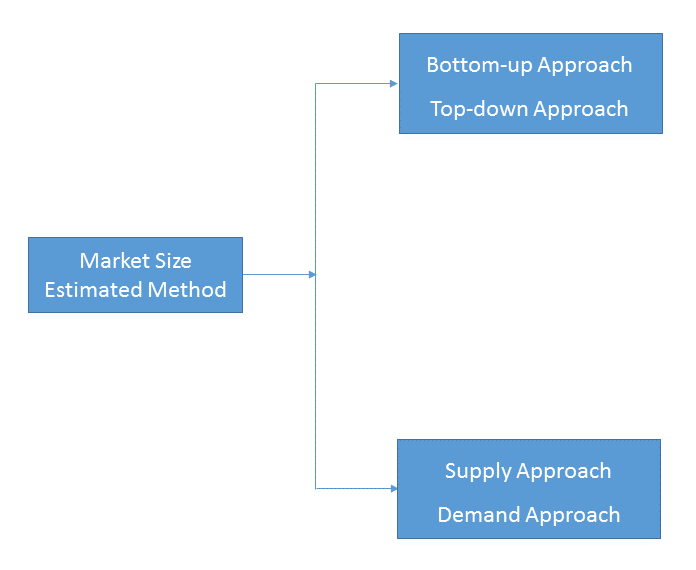
1)Top-down & Bottom-up Approach
Top-down approach uses a general market size figure and determines the percentage that the objective market represents.
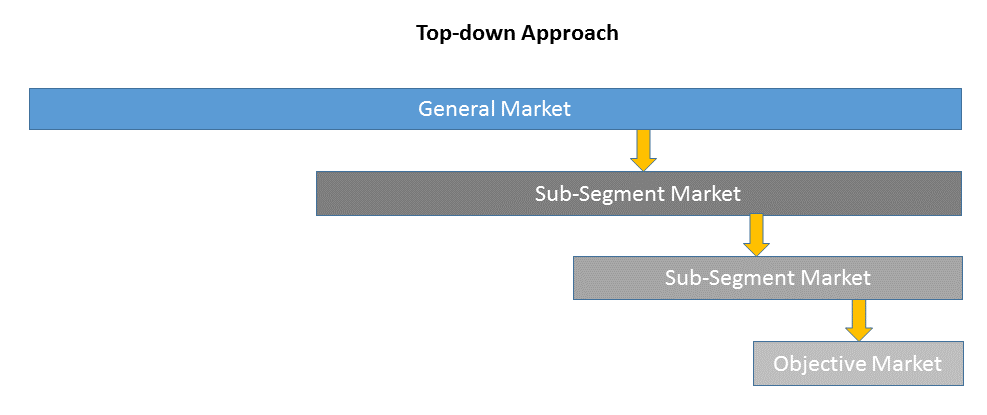
Bottom-up approach size the objective market by collecting the sub-segment information.

2)Supply & Demand Approach
Supply approach is based on assessments of the size of each competitor supplying the objective market.
Demand approach combine end-user data within a market to estimate the objective market size. It is sometimes referred to as bottom-up approach.
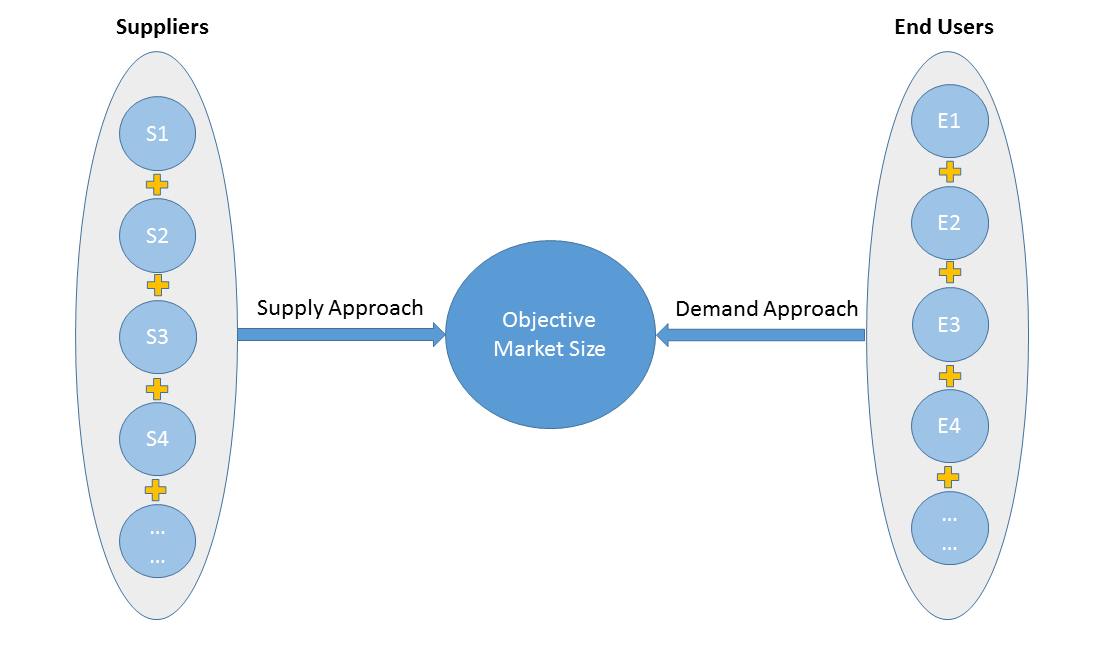
- Forecasting Methodology
- Numerous factors impacting the market trend are considered for forecast model:
- New technology and application in the future;
- New project planned/under contraction;
- Global and regional underlying economic growth;
- Threatens of substitute products;
- Industry expert opinion;
- Policy and Society implication.
- Analysis Tools
1)PEST Analysis
PEST Analysis is a simple and widely used tool that helps our client analyze the Political, Economic, Socio-Cultural, and Technological changes in their business environment.
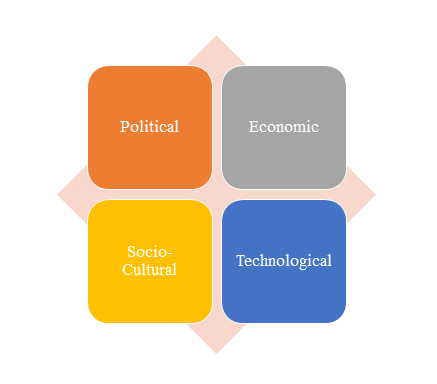
- Benefits of a PEST analysis:
- It helps you to spot business opportunities, and it gives you advanced warning of significant threats.
- It reveals the direction of change within your business environment. This helps you shape what you’re doing, so that you work with change, rather than against it.
- It helps you avoid starting projects that are likely to fail, for reasons beyond your control.
- It can help you break free of unconscious assumptions when you enter a new country, region, or market; because it helps you develop an objective view of this new environment.
2)Porter’s Five Force Model Analysis
The Porter’s Five Force Model is a tool that can be used to analyze the opportunities and overall competitive advantage. The five forces that can assist in determining the competitive intensity and potential attractiveness within a specific area.
- Threat of New Entrants: Profitable industries that yield high returns will attract new firms.
- Threat of Substitutes: A substitute product uses a different technology to try to solve the same economic need.
- Bargaining Power of Customers: the ability of customers to put the firm under pressure, which also affects the customer's sensitivity to price changes.
- Bargaining Power of Suppliers: Suppliers of raw materials, components, labor, and services (such as expertise) to the firm can be a source of power over the firm when there are few substitutes.
- Competitive Rivalry: For most industries the intensity of competitive rivalry is the major determinant of the competitiveness of the industry.
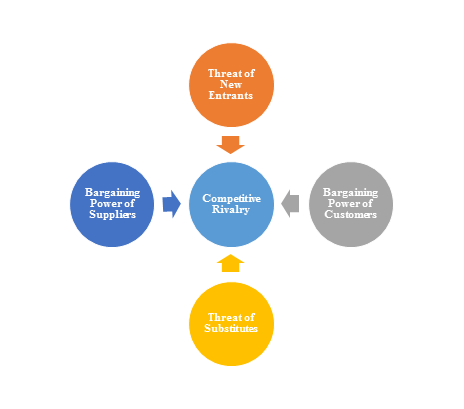
3)Value Chain Analysis
Value chain analysis is a tool to identify activities, within and around the firm and relating these activities to an assessment of competitive strength. Value chain can be analyzed by primary activities and supportive activities. Primary activities include: inbound logistics, operations, outbound logistics, marketing & sales, service. Support activities include: technology development, human resource management, management, finance, legal, planning.
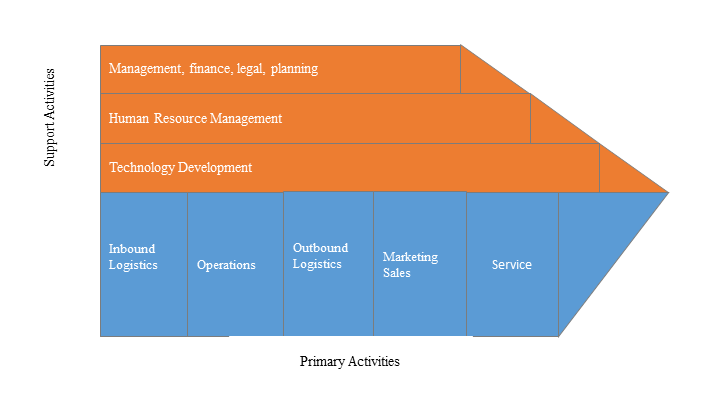
4)SWOT Analysis
SWOT analysis is a tool used to evaluate a company's competitive position by identifying its strengths, weaknesses, opportunities and threats. The strengths and weakness is the inner factor; the opportunities and threats are the external factor. By analyzing the inner and external factors, the analysis can provide the detail information of the position of a player and the characteristics of the industry.
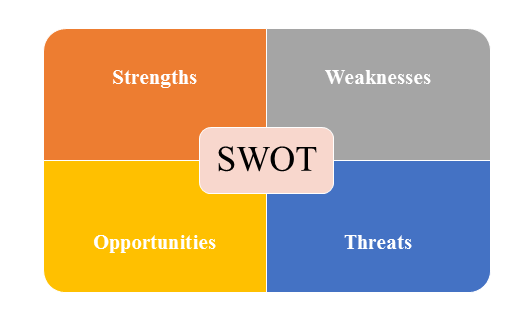
- Strengths describe what the player excels at and separates it from the competition
- Weaknesses stop the player from performing at its optimum level.
- Opportunities refer to favorable external factors that the player can use to give it a competitive advantage.
- Threats refer to factors that have the potential to harm the player.
- Data Sources
| Primary Sources | Secondary Sources |
|---|---|
| Face to face/Phone Interviews with market participants, such as: Manufactures; Distributors; End-users; Experts. Online Survey |
Government/International Organization Data: Annual Report/Presentation/Fact Book Internet Source Information Industry Association Data Free/Purchased Database Market Research Report Book/Journal/News |